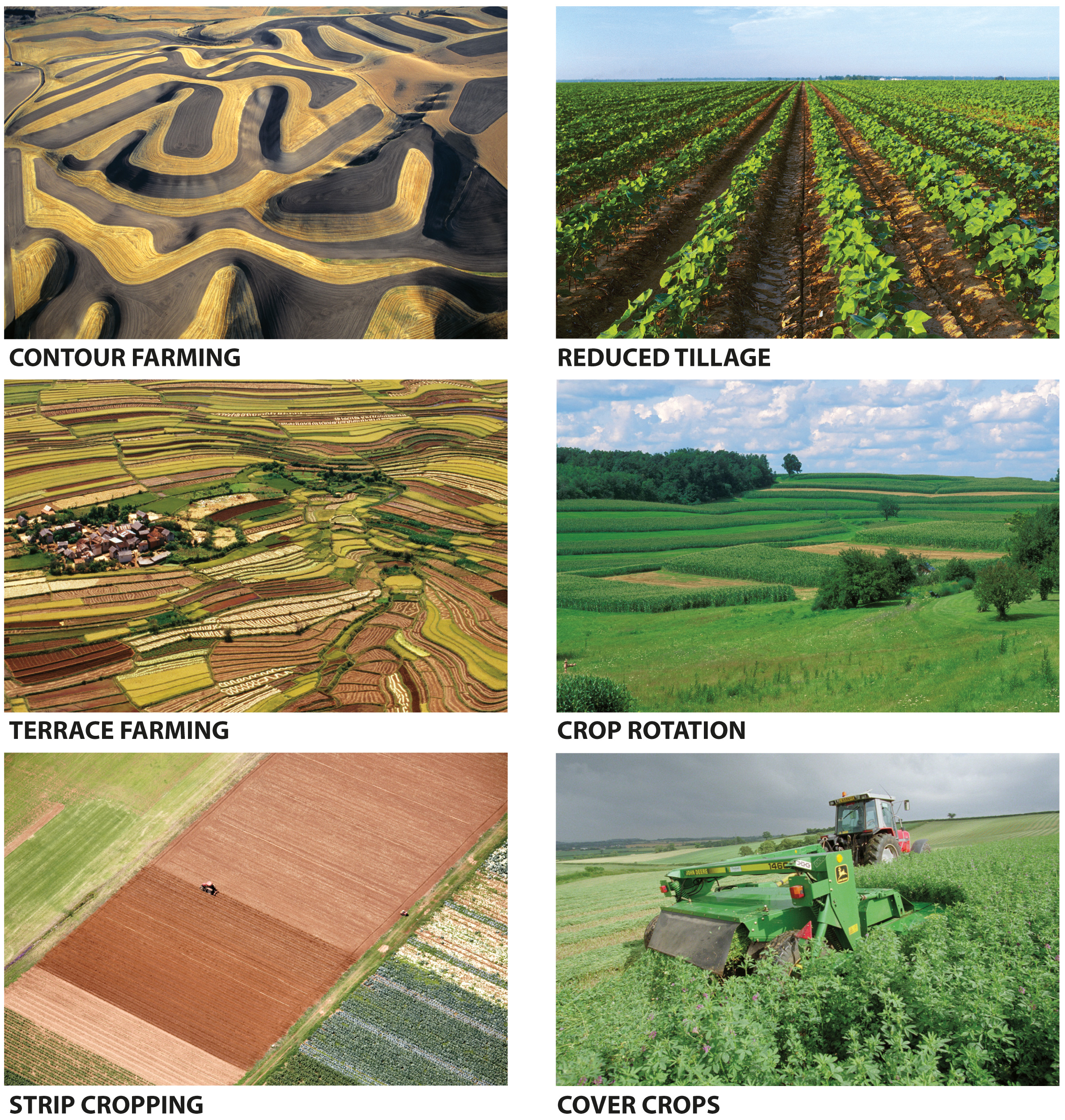
Chapter 18. Chapter 18: Agriculture
How can we sustainably produce crops or raise animals for food?

Guiding Question 18.3
How can we sustainably produce crops or raise animals for food?
Why You Should Care
There are several points to consider if we are to be able to feed future generations. First, there are the crops themselves: Can they be grown in a way that does not deplete soil resources and does not require excessive fertilizing? Will we have to convert more natural areas to farmland and pastures? Will we have to use poisons that could harm ecosystems, such as pesticides, herbicides, and antibiotics? Next, there are other natural resources to consider besides land: water, soil, and fossil fuels, especially. Farming requires lots of water, and fresh water is becoming an increasingly precious resource. So much water is diverted from the Colorado River for farming and domestic use in the Southwest, for example, that in some years, it does not actually reach its mouth and flow into the Gulf of California. Modern farming can compromise precious soil resources as well because tilling and overfarming can cause soil to be washed or blown away or to have too many nutrients removed with the crops. Intensive grazing, as we already know, can damage soil. Fossil fuels are required by modern agriculture for farm equipment, producing some fertilizers and pesticides, and shipping animals and produce, sometimes over very long distances.
To farm sustainably, we must start developing methods to reduce the need and use of these resources. Many small-scale efforts to farm more sustainably—such as organic farming, low- and no-till farming, and mixed cropping—are all garnering news and notice, but still only represent a small portion of the industry. For agriculture to be truly sustainable, there must be large-scale "buy-in" by consumers.
1.
Takao Furuno's farming method relies on _____________, whereas most modern, "Green Revolution" farming systems rely on ______________.
| A. |
| B. |
| C. |
| D. |
2.
When referring to Furuno’s rice-growing method, it is true to say that:
| A. |
| B. |
| C. |
| D. |
3.
Ducks are important to Furuno’s rice-paddy ecosystem because they:
| A. |
| B. |
| C. |
| D. |
4.
It is best for Furuno’s methods if there is:
| A. |
| B. |
| C. |
| D. |
5.
Click on the parts of Furuno's integrated rice-farming system that can be sold.
{"title":"Duck","description":"Ducks are one of the parts of the system that can be sold. Click all parts of the system that can be sold to complete the question.","type":"correct","color":"#99CCFF","code":"[{\"shape\":\"poly\",\"coords\":\"203,77,208,74,222,67,228,60,220,65,226,58,230,56,237,57,242,62,246,68,246,76,244,81,247,86,246,88,253,84,259,80,264,78,270,76,283,74,297,75,311,76,328,78,340,77,329,95,324,100,305,103,294,105,259,108,247,106,234,103,223,96,218,89,218,86,221,80,224,74,218,69,224,75,208,80,198,76,221,64,226,64\"}]"} {"title":"Fish","description":"Fish are one of the parts of the system that can be sold. Click all parts of the system that can be sold to complete the question.","type":"correct","color":"#993300","code":"[{\"shape\":\"poly\",\"coords\":\"180,188,178,176,180,188,182,192,192,193,205,189,212,186,218,187,224,187,228,185,230,183,226,180,237,177,243,174,246,173,254,175,258,176,263,173,259,172,254,170,264,167,278,160,286,161,294,161,298,159,298,157,291,157,291,154,311,151,324,138,320,127,280,145,262,147,264,142,260,139,255,135,242,139,240,146,234,152,196,171,178,186\"}]"} {"title":"Rice","description":"Rice is one of the parts of the system that can be sold. Click all parts of the system that can be sold to complete the question.","type":"correct","color":"#333300","code":"[{\"shape\":\"rect\",\"coords\":\"99,11,184,203\"}]"} {"title":"Azolla","description":"Azolla does not have a market value.","type":"incorrect","color":"#000080","code":"[{\"shape\":\"poly\",\"coords\":\"266,112,268,138,185,147,189,112,189,112\"}]"}6.
Click on the parts of Furuno's integrated rice-farming system that must always have water to live.
{"title":"Duck","description":"","type":"incorrect","color":"#99CCFF","code":"[{\"shape\":\"poly\",\"coords\":\"203,77,208,74,222,67,228,60,220,65,226,58,230,56,237,57,242,62,246,68,246,76,244,81,247,86,246,88,253,84,259,80,264,78,270,76,283,74,297,75,311,76,328,78,340,77,329,95,324,100,305,103,294,105,259,108,247,106,234,103,223,96,218,89,218,86,221,80,224,74,218,69,224,75,208,80,198,76,221,64,226,64\"}]"} {"title":"Fish","description":"","type":"correct","color":"#993300","code":"[{\"shape\":\"poly\",\"coords\":\"180,188,178,176,180,188,182,192,192,193,205,189,212,186,218,187,224,187,228,185,230,183,226,180,237,177,243,174,246,173,254,175,258,176,263,173,259,172,254,170,264,167,278,160,286,161,294,161,298,159,298,157,291,157,291,154,311,151,324,138,320,127,280,145,262,147,264,142,260,139,255,135,242,139,240,146,234,152,196,171,178,186\"}]"} {"title":"Rice","description":"","type":"incorrect","color":"#333300","code":"[{\"shape\":\"rect\",\"coords\":\"99,11,184,203\"}]"} {"title":"Azolla","description":"","type":"correct","color":"#000080","code":"[{\"shape\":\"poly\",\"coords\":\"266,112,268,138,185,147,189,112,189,112\"}]"}7.
Click on the parts of Furuno's integrated rice-farming system that provide fertilizer for the rice.
{"title":"Duck","description":"","type":"correct","color":"#99CCFF","code":"[{\"shape\":\"poly\",\"coords\":\"203,77,208,74,222,67,228,60,220,65,226,58,230,56,237,57,242,62,246,68,246,76,244,81,247,86,246,88,253,84,259,80,264,78,270,76,283,74,297,75,311,76,328,78,340,77,329,95,324,100,305,103,294,105,259,108,247,106,234,103,223,96,218,89,218,86,221,80,224,74,218,69,224,75,208,80,198,76,221,64,226,64\"}]"} {"title":"Fish","description":"","type":"correct","color":"#993300","code":"[{\"shape\":\"poly\",\"coords\":\"180,188,178,176,180,188,182,192,192,193,205,189,212,186,218,187,224,187,228,185,230,183,226,180,237,177,243,174,246,173,254,175,258,176,263,173,259,172,254,170,264,167,278,160,286,161,294,161,298,159,298,157,291,157,291,154,311,151,324,138,320,127,280,145,262,147,264,142,260,139,255,135,242,139,240,146,234,152,196,171,178,186\"}]"} {"title":"Rice","description":"","type":"incorrect","color":"#333300","code":"[{\"shape\":\"rect\",\"coords\":\"99,11,184,203\"}]"} {"title":"Azolla","description":"","type":"correct","color":"#000080","code":"[{\"shape\":\"poly\",\"coords\":\"266,112,268,138,185,147,189,112,189,112\"}]"}8.
Click on the parts of Furuno's integrated rice-farming system that are considered pests in typical modern rice plantations.
{"title":"Duck","description":"","type":"correct","color":"#99CCFF","code":"[{\"shape\":\"poly\",\"coords\":\"203,77,208,74,222,67,228,60,220,65,226,58,230,56,237,57,242,62,246,68,246,76,244,81,247,86,246,88,253,84,259,80,264,78,270,76,283,74,297,75,311,76,328,78,340,77,329,95,324,100,305,103,294,105,259,108,247,106,234,103,223,96,218,89,218,86,221,80,224,74,218,69,224,75,208,80,198,76,221,64,226,64\"}]"} {"title":"Fish","description":"","type":"incorrect","color":"#993300","code":"[{\"shape\":\"poly\",\"coords\":\"180,188,178,176,180,188,182,192,192,193,205,189,212,186,218,187,224,187,228,185,230,183,226,180,237,177,243,174,246,173,254,175,258,176,263,173,259,172,254,170,264,167,278,160,286,161,294,161,298,159,298,157,291,157,291,154,311,151,324,138,320,127,280,145,262,147,264,142,260,139,255,135,242,139,240,146,234,152,196,171,178,186\"}]"} {"title":"Rice","description":"","type":"incorrect","color":"#333300","code":"[{\"shape\":\"rect\",\"coords\":\"99,11,184,203\"}]"} {"title":"Azolla","description":"","type":"correct","color":"#000080","code":"[{\"shape\":\"poly\",\"coords\":\"266,112,268,138,185,147,189,112,189,112\"}]"}9.
Thought Question: How is Furuno's system a more sustainable way to grow rice than current methods? Would you also consider the fish and ducks raised in Furuno's rice fields to be produced sustainably?

For each of the following descriptors, select ALL of the farming methods that apply:
10.
Reduces erosion
Contour farming
Terrace farming
Reduced tillage
Cover crops
Crop rotation
Strip farming
11.
Better for slopes
Contour farming
Terrace farming
Reduced tillage
Cover crops
Crop rotation
Strip farming
12.
Reduces effects of crop pests
Contour farming
Terrace farming
Reduced tillage
Cover crops
Crop rotation
Strip farming
13.
Maintains or improves soil fertility
Contour farming
Terrace farming
Reduced tillage
Cover crops
Crop rotation
Strip farming
14.
Reduces water needs
Contour farming
Terrace farming
Reduced tillage
Cover crops
Crop rotation
Strip farming
15.
Reduces fuel needs
Contour farming
Terrace farming
Reduced tillage
Cover crops
Crop rotation
Strip farming
16.
Always involve planting a variety of crops
Contour farming
Terrace farming
Reduced tillage
Cover crops
Crop rotation
Strip farming
Activity results are being submitted...
